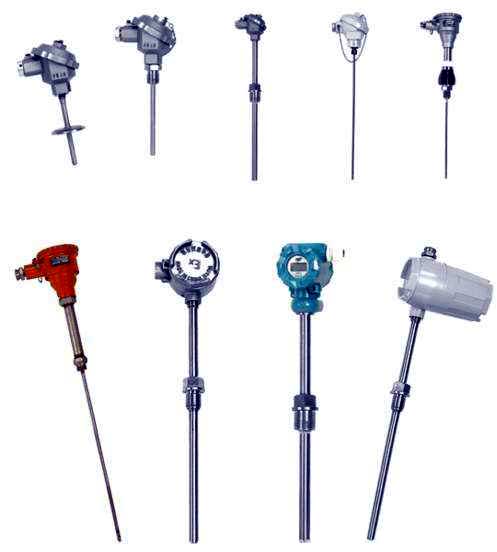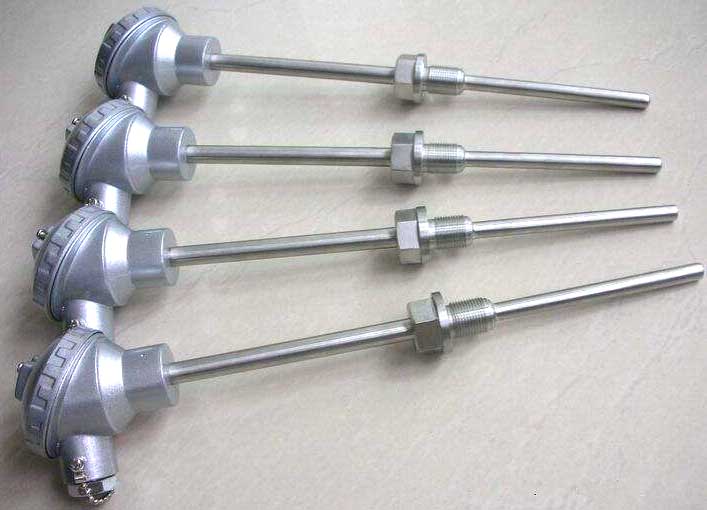Application Principle, Classification and Structure Formation of Thermocouple Temperature Sensor
Thermocouple temperature sensor is one of the most commonly used temperature detection components in industry. Its advantages are:
1, the measurement accuracy is high. Because the temperature sensor thermocouple directly contacts the object to be tested, it is not affected by the intermediate medium.
2, a wide range of measurement. Commonly used temperature sensor thermocouples can be continuously measured from -50 to +1600 °C. Some special temperature sensor thermocouples can measure -269 °C (such as gold-iron nickel-chromium), up to +2800 °C (such as tungsten-bismuth). ).
3, the structure is simple, easy to use. Temperature sensor thermocouples are usually made up of two different wires and are not limited by size and opening. They have a protective sleeve and are very convenient to use.

1. Temperature sensor thermocouple temperature measurement basic principle
Conductors or semiconductors A and B of two different materials are welded to form a closed loop. When there is a temperature difference between the two attachment points 1 and 2 of the conductors A and B, an electromotive force is generated between the two, thereby forming a current of a magnitude in the loop, which is called a thermoelectric effect. Temperature sensor thermocouples use this effect to work.
2. Temperature sensor thermocouple type and structure formation
(1) Type of temperature sensor thermocouple
Commonly used temperature sensor thermocouples can be divided into two types: standard temperature sensor thermocouples and non-standard temperature sensor thermocouples.
The so-called standard temperature sensor thermocouple refers to a temperature sensor thermocouple whose national standard specifies the relationship between its thermoelectric potential and temperature, the allowable error, and a uniform standard index table. It has a display instrument that is compatible with it.
Non-standardized temperature sensor thermocouples are not as useful or standardized as temperature sensor thermocouples. There is generally no uniform indexing table, which is mainly used for measurement in some special occasions.

1, the measurement accuracy is high. Because the temperature sensor thermocouple directly contacts the object to be tested, it is not affected by the intermediate medium.
2, a wide range of measurement. Commonly used temperature sensor thermocouples can be continuously measured from -50 to +1600 °C. Some special temperature sensor thermocouples can measure -269 °C (such as gold-iron nickel-chromium), up to +2800 °C (such as tungsten-bismuth). ).
3, the structure is simple, easy to use. Temperature sensor thermocouples are usually made up of two different wires and are not limited by size and opening. They have a protective sleeve and are very convenient to use.

1. Temperature sensor thermocouple temperature measurement basic principle
Conductors or semiconductors A and B of two different materials are welded to form a closed loop. When there is a temperature difference between the two attachment points 1 and 2 of the conductors A and B, an electromotive force is generated between the two, thereby forming a current of a magnitude in the loop, which is called a thermoelectric effect. Temperature sensor thermocouples use this effect to work.
2. Temperature sensor thermocouple type and structure formation
(1) Type of temperature sensor thermocouple
Commonly used temperature sensor thermocouples can be divided into two types: standard temperature sensor thermocouples and non-standard temperature sensor thermocouples.
The so-called standard temperature sensor thermocouple refers to a temperature sensor thermocouple whose national standard specifies the relationship between its thermoelectric potential and temperature, the allowable error, and a uniform standard index table. It has a display instrument that is compatible with it.
Non-standardized temperature sensor thermocouples are not as useful or standardized as temperature sensor thermocouples. There is generally no uniform indexing table, which is mainly used for measurement in some special occasions.
Standardized temperature sensor thermocouple: Since January 1, 1988, the temperature sensor thermocouple and temperature sensor thermal resistance are all produced according to IEC international standards. And specify seven kinds of standardized temperature sensor thermocouples S, B, E, K, R, J, T for China's unified design temperature sensor thermocouple.
(2) Structural form of temperature sensor thermocouple
In order to ensure reliable and stable operation of the temperature sensor thermocouple, its structural requirements are as follows:
1, the welding of the two hot electrodes that make up the temperature sensor thermocouple must be firm;
2, the two hot electrodes should be well insulated from each other to prevent short circuits;
3, The connection between the compensation wire and the free end of the temperature sensor thermocouple should be convenient and reliable;
4, the protective sleeve should ensure that the hot electrode is fully isolated from harmful media.
3. Temperature compensation of the cold junction of the temperature sensor thermocouple
Because the temperature sensor thermocouple material is generally more expensive (especially when using precious metals). The distance between temperature measuring point and instrument is very long, in order to save thermocouple material and reduce cost. A compensation wire is usually used to extend the cold end (free end) of the temperature sensor thermocouple to a relatively stable temperature control chamber and to the meter terminals. It must be pointed out that the temperature sensor thermocouple compensation wire acts only to extend the hot electrode, moving the cold end of the temperature sensor thermocouple to the meter terminal of the control room. It does not eliminate the effect of cold junction temperature changes on temperature measurement, and does not compensate. Therefore, other correction methods are needed to compensate for the influence of the cold junction temperature t0 ≠ 0 ° C on the temperature measurement.
When using the temperature sensor thermocouple compensation wire, you must pay attention to the model matching, the polarity can not be connected wrong, the temperature of the compensation wire and the temperature sensor thermocouple connection terminal can not exceed 100 °C.
(2) Structural form of temperature sensor thermocouple
In order to ensure reliable and stable operation of the temperature sensor thermocouple, its structural requirements are as follows:
1, the welding of the two hot electrodes that make up the temperature sensor thermocouple must be firm;
2, the two hot electrodes should be well insulated from each other to prevent short circuits;
3, The connection between the compensation wire and the free end of the temperature sensor thermocouple should be convenient and reliable;
4, the protective sleeve should ensure that the hot electrode is fully isolated from harmful media.
3. Temperature compensation of the cold junction of the temperature sensor thermocouple
Because the temperature sensor thermocouple material is generally more expensive (especially when using precious metals). The distance between temperature measuring point and instrument is very long, in order to save thermocouple material and reduce cost. A compensation wire is usually used to extend the cold end (free end) of the temperature sensor thermocouple to a relatively stable temperature control chamber and to the meter terminals. It must be pointed out that the temperature sensor thermocouple compensation wire acts only to extend the hot electrode, moving the cold end of the temperature sensor thermocouple to the meter terminal of the control room. It does not eliminate the effect of cold junction temperature changes on temperature measurement, and does not compensate. Therefore, other correction methods are needed to compensate for the influence of the cold junction temperature t0 ≠ 0 ° C on the temperature measurement.
When using the temperature sensor thermocouple compensation wire, you must pay attention to the model matching, the polarity can not be connected wrong, the temperature of the compensation wire and the temperature sensor thermocouple connection terminal can not exceed 100 °C.






